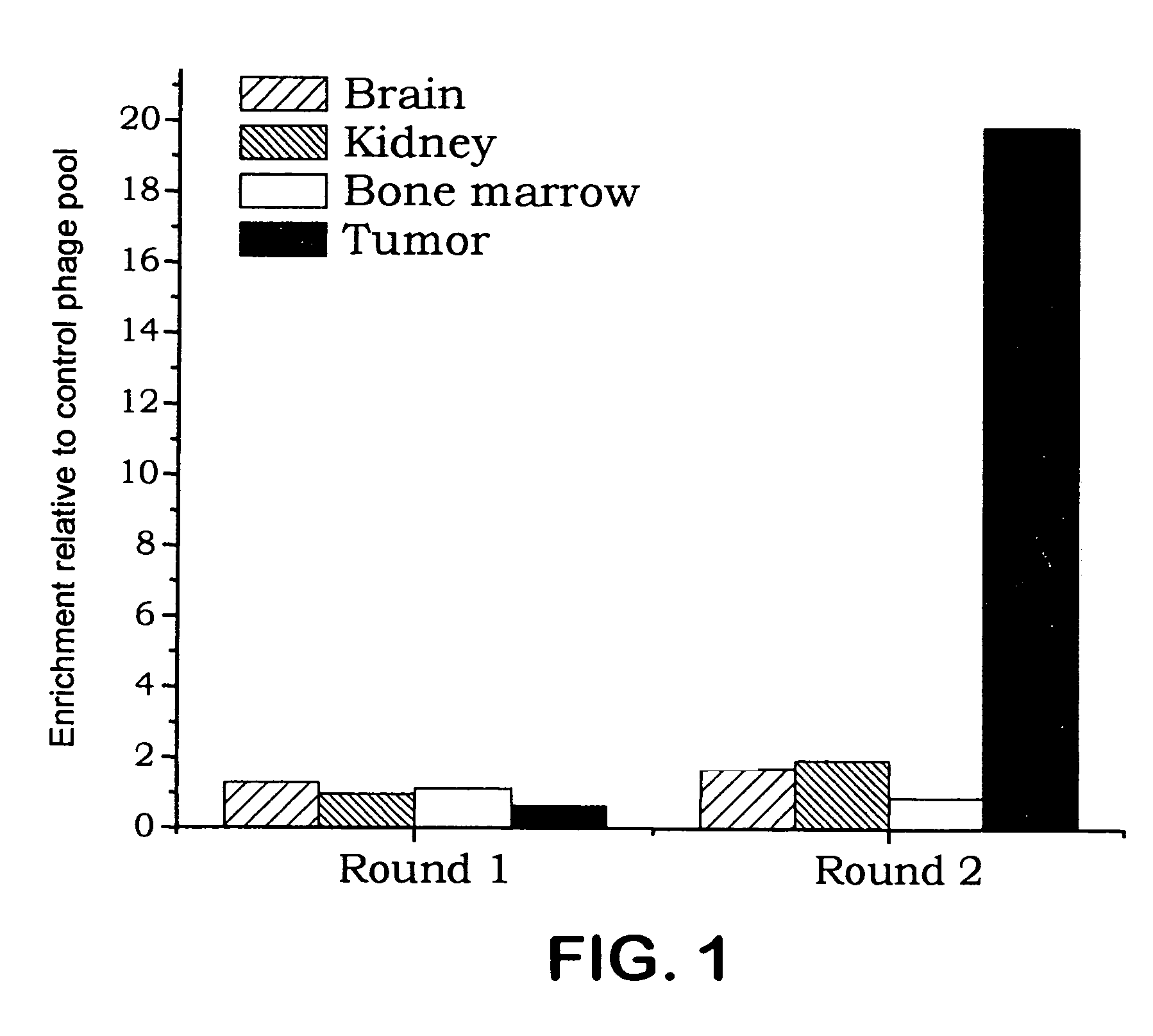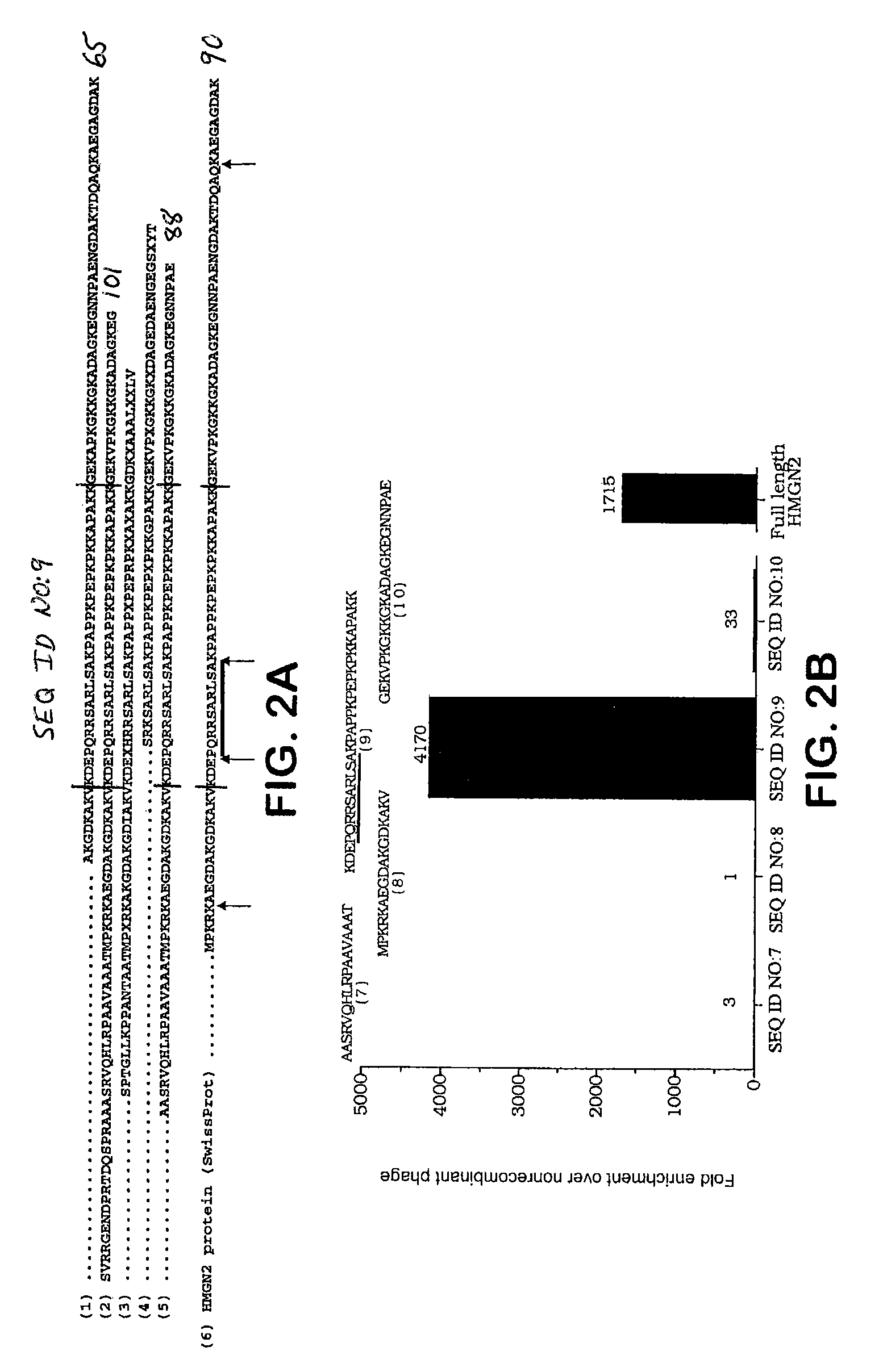HMGN2 peptides and related molecules that selectively home to tumor blood vessels and tumor cells
a tumor and blood vessel technology, applied in the field of tumors, molecular medicine and drug delivery, can solve the problems of scarring and loss of normal tissue, lack of effective selective targeting agents, and substantial damage to organs such as bone marrow, mucosa, skin and small intestine, which undergo rapid cell turnover and continuous cell division, so as to and reduce the number of tumor blood vessels
- Summary
- Abstract
- Description
- Claims
- Application Information
AI Technical Summary
Benefits of technology
Problems solved by technology
Method used
Image
Examples
example i
In Vivo Homing of a Fragment of HMGN2
[0129]This example demonstrates that an amino-terminal fragment of HMGN2 selectively homes to tumor blood vessels and tumor cells in vivo.
[0130]Hematopoietic and endothelial precursors originate from a common precursor, hemangioblasts. Based on the shared phenotypic characteristics of hematopoietic and endothelial precursors, a phage screening procedure was devised to select cDNA clones that bind an epitope shared by both primitive bone marrow cells and angiogenic endothelial cells. The screening procedure included an ex vivo primary selection on lineage-depleted murine bone marrow cells to select for binding to endothelial progenitor cells and a further selection for homing to HL-60 xenograft tumors in vivo.
[0131]After two rounds of pre-selection on lineage-depleted murine bone marrow cells, the resulting phage pool was injected into the tail vein of nude mice bearing HL-60 tumors. After 10 minutes of circulation, the mice were perfused through ...
example ii
Delineation of the HMGN2 Tumor Cell-Binding Domain
[0139]This example describes localization of the HMGN2 domain responsible for tumor cell binding and in vivo homing activity.
A. Identification of an HMGN2-Derived Peptide Sequence Sufficient for Tumor Cell Binding and in Vivo Homing Activity.
[0140]Phage displaying a set of sequences corresponding to fragments of the amino-terminal portion of HMGN2 (SEQ ID NO: 5) were constructed to localize the region responsible for cell binding and in vivo homing. Fragments were designed to follow the exon / intron boundaries of the HMGN2 gene. Inserts encoding the indicated fragments were amplified from the full length HMGN2 phage clone by PCR, purified, digested and directionally cloned into the T7 415-1 and 10-3 vectors. Phage were packaged, amplified and sequenced according to the manufacturer's instructions. Phage preparations were then tested for binding to primary cells obtained from HL-60 xenograft tumors. After a 1 hour incubation at 4° C., ...
example iii
Tissue and Sub-Cellular Localization of HMGN2 Peptide SEQ ID NO: 9
[0144]This example demonstrates that peptide SEQ ID NO: 9 accumulates in tumor cells and cells lining the blood vessels upon intravenous administration.
A. Histological Analysis of HMGN2 Peptide Homing
[0145]To study peptide localization, fluorescein-conjugated SEQ ID NO: 9 or ARALPSQRSR (SEQ ID NO: 13) was injected into the tail vein of mice bearing HL-60 or MDA-MB-435 xenografts. Peptide injection was followed 10 minutes later by injection of biotinylated tomato lectin, a marker of the vasculature. After another five minutes, mice were perfused through the heart with fixative solution, and the organs dissected, sectioned and stained with streptavidin-AlexaFluor 594. Slides were counter-stained with DAPI and examined under an inverted fluorescent microscope. As shown in FIG. 3A, strong fluorescence was present in tumor tissue, whereas little or no specific fluorescence was detected in normal brain, liver or spleen. See...
PUM
| Property | Measurement | Unit |
|---|---|---|
| apparent molecular weight | aaaaa | aaaaa |
| time | aaaaa | aaaaa |
| time | aaaaa | aaaaa |
Abstract
Description
Claims
Application Information
 Login to View More
Login to View More - R&D
- Intellectual Property
- Life Sciences
- Materials
- Tech Scout
- Unparalleled Data Quality
- Higher Quality Content
- 60% Fewer Hallucinations
Browse by: Latest US Patents, China's latest patents, Technical Efficacy Thesaurus, Application Domain, Technology Topic, Popular Technical Reports.
© 2025 PatSnap. All rights reserved.Legal|Privacy policy|Modern Slavery Act Transparency Statement|Sitemap|About US| Contact US: help@patsnap.com



